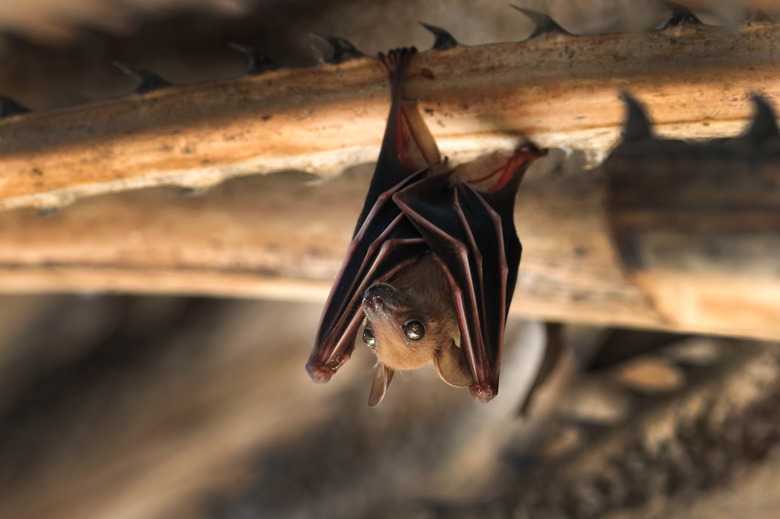Bumblebee Bat Facts
Bumblebee bats (Craseonycteris thonglongyai) live in limestone caves found near rivers in the forests of Thailand and Myanmar. These tiny mammals only ever stray about 0.62 miles (1 kilometer) from their home cave.
The main threat to these bats is interference by humans. Humans often visit these bats caves for tourism. Bats are collected and dried for sale as souvenirs or people disturb them while collecting their guano for fertilizer, which is used to increase the nutritional value of vegetable crops.
The Smallest Mammal in the World
The Smallest Mammal in the World
The head to body length of these bats is only 1.14 to 1.3 inches long (29 to 33 millimeters), making them the tiniest known mammals in the world.
Their wingspan reaches 6.7 inches (170 mm). On average they weigh a mere 0.7 ounces (2 grams).
Bumblebee Bat Appearance
Bumblebee Bat Appearance
People often describe bumblebee bats as having pig-like face due to their large nostrils with a wide septum. These tiny brownish red or grey bats have a few unique physical characteristics. Firstly, despite having two caudal vertebrae, they don't have a tail. Additionally, for such small animals, they have large ears measuring 0.4 inches (10.2 millimeters).
The males can be differentiated from the females by a large swelling of a gland at the base of their throats. Females also have a second set of nipples near their groin. This second set of nipples appears to be vestigial as they no longer function.
Bat Lifespan and Lifecycle
Bat Lifespan and Lifecycle
Also known as kitti's hog-nosed bat, very little is known about the lifespan and breeding behaviors of bumblebee bats. Based on similar species, researchers estimate they live between five and 10 years. They are thought to have one offspring once a year and breed in late April.
Social Structures
These bats live in roosts of 10 and up to 100 individuals. Living in roosts is beneficial for keeping warm and finding mates. Despite these bats residing in colonies, they are not particularly sociable. Females roost alone in a nursery cave when rearing offspring.
Diet
Diet
These bats forage in the bamboo forest canopies around their caves to find food. They mainly feast on insects.
Bats will collect the insects either by catching them mid-flight or nibbling them off leaves. As insectivores, they can be beneficial for humans as they can help control insect pests in the area.
Perception
Perception
Like all other bats, the bumblebee bat uses echolocation to view the world around them and find food. Bats emit ultrasonic sounds from their nose or mouth. When the sound hits an object, it bounces back to the bat. The bats listen to the sound to determine the size and shape of the object in front of them.
Echolocation allows bats to see the world even in what looks to humans like complete darkness. They can detect even the smallest of mosquitos to eat. Echolocation also stops them from flying into objects.
Humans are unable to hear the ultrasonic sounds bats emit for echolocation, but some prey animals such as moths can recognize when echolocation is being used and adjust their flight pattern to try and confuse the bats.
Bumblebee Bat Behavior
Bumblebee Bat Behavior
While little is known about bumblebee bats, we know they behave in a similar way to many other bat species. They are most active during dusk and dawn, although they tend to be active longer at dusk than dawn.
When they are not active, they are thought to enter states of torpor. During torpor animals reduce their movement, body temperature and metabolic rate to save energy.
Watch Bumblebee Bats Safely
Watch Bumblebee Bats Safely
Visiting bat caves to see the worlds smallest mammal is tempting for many curious tourists, but it is potentially dangerous. While guides and people may be tempted to hold the tiny creatures, this interferes with the bats' natural behaviors, and if bitten, humans can contract infections.
The best way to see these bats safely is to visit the outside of one of the caves in the National Park in Kanchanaburi Province, Thailand at dusk or dawn to watch them fly around feeding.
Cite This Article
MLA
Jerrett, Adrianne. "Bumblebee Bat Facts" sciencing.com, https://www.sciencing.com/bumblebee-bat-6005965/. 22 November 2019.
APA
Jerrett, Adrianne. (2019, November 22). Bumblebee Bat Facts. sciencing.com. Retrieved from https://www.sciencing.com/bumblebee-bat-6005965/
Chicago
Jerrett, Adrianne. Bumblebee Bat Facts last modified March 24, 2022. https://www.sciencing.com/bumblebee-bat-6005965/
